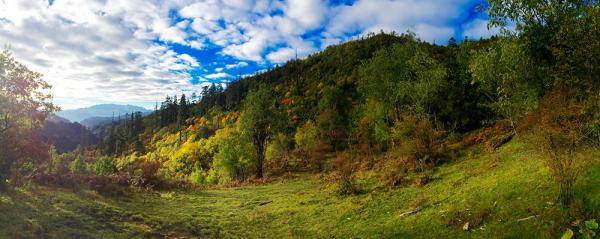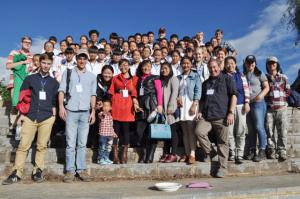Educating for Sustainability in China
Maple trees were in full fall foliage, glowing red, orange, and yellow. Dozens of species of giant rhododendron populated the forest understory. Massive spruce trees towered above the canopy, draped in long lichen hanging like tinsel. Cold mornings and very warm sunny days at elevations above 10,000 feet. It was like being in a forest in the Southeast, New England, the Rockies, and the Pacific Northwest all at once!
I took this weeklong journey to Yunnan Province, China to work with staff from Middlebury College Sustainability Integration Office, Middlebury's International School of Kunming (MSK), and The Nature Conservancy (TNC) to support local sustainability efforts in schools and communities surrounding the “small city” (of about 4 million people) of Kunming. The American college students studying at MIC Kunming were not necessarily from Middlebury College, and many had never been to Vermont before, but we did draw comparisons between the sustainability issues we face in protecting wetlands in the Lake Champlain basin and similar issues TNC is working on with rural farmers near the lakes and wetlands of Yunnan Province.
While the cultural and political context we were operating in couldn't be more different from Vermont, we were still able to share Education for Sustainability practices that the students found engaging and teachers found intriguing. I was tasked with leading an outdoor, hands-on “demonstration lesson” in a place I’d never been in a language I did not speak. So I met the MIC Kunming students and gave them a 30-minute crash course in our approach to education. Only a few were environmental studies students, and some had backgrounds working with children. But their Chinese language skills were impressive, and would be the key in making the hands-on wetland exploration stations work.
We bought materials the day I arrived – plastic cups, dipping nets, buckets, strainers, and dumpling trays to hold any critters we found in the wetlands. We printed off color wheels of the full spectrum as well as shades of green, and got 10 binoculars from The Nature Conservancy.
Afterwards, the students noted that they don’t leave the classroom for these kinds of explorations. A teacher also remarked that the student who spoke up when we were debriefing what we had learned was someone who rarely contributes. By those measures alone, our efforts were successful in introducing a new framework for environmental for sustainability. As The Nature Conservancy expands environmental education in the region, we will continue to advise them to help them be successful.
After the visit to the middle school, the trip became more of a learning journey to understand some of the major conservation issues of the region. This focused around efforts to protect the endangered Golden Snub-nosed Monkey, the highest-elevation primate species on the planet (aside from humans). They live in the forest described above, and can be found at elevations up to 14,000 ft. Only 5,000 exist on the planet, and only about 300 in the protected area we visited. We knew it would be highly unlikely to see one.In each of the next three semesters, new MIC Kunming college students will participate in this week-long workshop, building upon the success of the previous semester. The goal is to solidify the partnership between MIC Kunming and TNC in the region. Students will benefit from using their Chinese language skills to learn more about the area’s environmental issues. TNC will be able to explore how they can use some of our best practices in education to further their conservation efforts.
Will I return? That is yet to be seen, but I could be easily lured by the possibility to encounter the mysterious monkey that eluded us this time, and to continue to share our education for sustainability practices with communities on the other side of the world.






